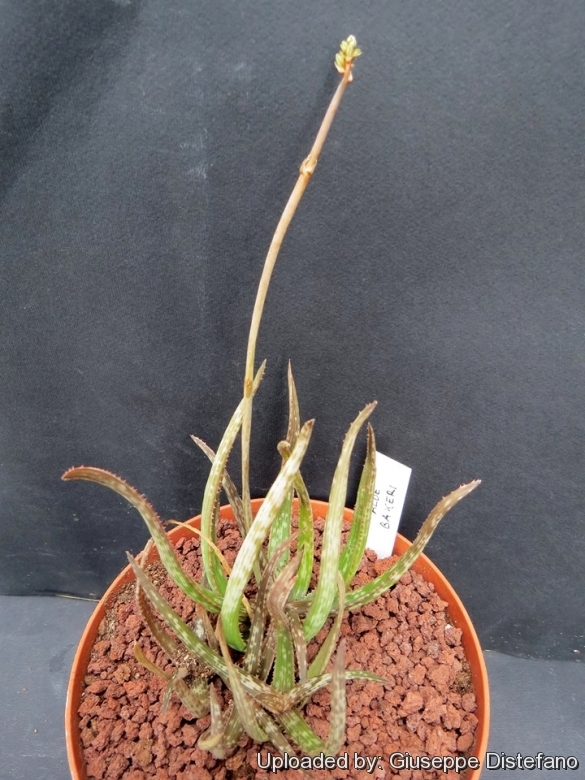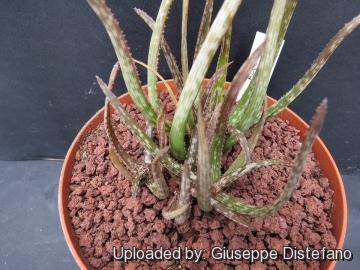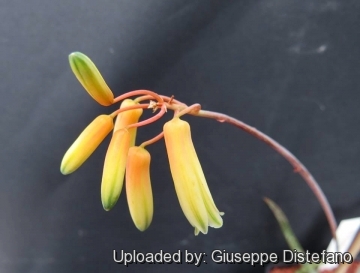Accepted Scientific Name: Aloe bakeri Scott-Elliot
J. Linn. Soc., Bot. 29: 60 (1891)

Guillauminia bakeri (Aloe bakeri) Photo by: Giuseppe Distefano
Origin and Habitat: Aloe bakeriSN|30409]]SN|30409]] is a species of flowering plant in the family Aloaceae (Xanthorrhoeaceae), endemic to Madagascar.
Altitude: About 0-500 metres above sea level.
Habitat and ecology: This species grows in humid, or subhumid areas, in shallow soils and crevices on inselberg/rock faces (and on sand-dunes?).
Synonyms:
Common Names include:
ENGLISH: Baker aloe, Dwarf Aloe
FINNISH (Suomi): Toliaranaaloe
SWEDISH (Svenska): Brokaloe
UKRAINIAN (Українська): Алое Бейкера, Алое Бакера
Description: Aloe bakeriSN|30409]]SN|30409]] is a caulescent, branching and suckering, evergreen succulent plant. It slowly forms a mat of up to 100 or more shoots, to 10–20 cm tall by 40 cm wide, of spidery succulent green or reddish-green toothed leaves, heavily mottled with white. In summer it produces red or orange, green-tipped tubular flowers in racemes.
Derivation of specific name: The Latin specific epithet bakeri honours one of two British horticulturalists, in this case John Gilbert Baker of Kew (1834-1920).
Stem: 10-20 cm long, 0.5-0.7 cm in diameter producing offsets at the base.
Leaves: About 12 per rosette, 7-9 cm long, 0,8-1 cm broad at base (often longer in cultivation), triangular, attenuate-acute, dark green tinged reddish, unspotted or with pale green or dull white spots (few on upper face, many underneath). Marginal teeth white, straight or slightly curved, firm, about 1 mm long, 1-2 mm apart. Sheath 5-10 mm long.
Inflorescence: Scape simple 25-30 cm long, bracts ovate-acuminate, 2-3 mm long, scarious. Raceme lax, 8-10 flowered, subcapitate, on the last 2-4 cm of the stalk. Pedicels usually about 10-12 mm long.
Flowers: About 23 mm long and 8 mm broad, nodding. Perianth, cylindric, orange or apricot scarlet at the base becoming orange or yellow towards the mouth, quite glabrous, base shortly tapering, narrowed slightly above ovary, then enlarging towards mouth. Segments short (5 mm.) free to base, greenish topped, obtuse, marked by 3-5 black nerves converging at the tip. Stamens exerted 0-1 mm; filaments flattened; anthers c. 3 mm long. Style simple projecting.
Fruits (capsules): Ellipsoidal, 1.2 cm long and 6 mm broad.
Chromosome number: 2n = 14
Bibliography: Major references and further lectutres
1) Wikipedia contributors. "Aloe bakeri." Wikipedia, The Free Encyclopedia. Wikipedia, The Free Encyclopedia, 17 Jul. 2013. Web. 3 Feb. 2015.
2) “RHS A-Z encyclopedia of garden plants.” United Kingdom: Dorling Kindersley. p. 1136. 2008
3) Harrison, Lorraine “RHS Latin for gardeners.” United Kingdom: Mitchell Beazley. p. 224. 2012
4) Walters, S.M. “The European Garden Flora, Vol. 1. Pteridophyta; Gymnospermae; Angiospermae — Alismataceae to Iridaceae.” 1986
5) G. F. Scott Elliot “New and little known Madagascar plants” In: Journal of the Linnean Society. Botany 29(197): 60, 1891
6) “Aloe bakeri Scott-Elliot (1891)“ http://www.aloes.wz.cz/bakeen.htm Web. 3 Feb. 2015.
7) Susan Carter, John J. Lavranos, Leonard E. Newton, Colin C. Walker “Aloes. The definitive guide.” Kew Publishing, Royal Botanic Gardens, Kew 2011,
8) Leonard Eric Newton: Aloe bakeri. In: Urs Eggli (Hrsg.): “Sukkulenten-Lexikon. Einkeimblättrige Pflanzen (Monocotyledonen).” Eugen Ulmer, Stuttgart 2001
9) Urs Eggli, Leonard E. Newton “Etymological Dictionary of Succulent Plant Names” Springer, Berlin/Heidelberg 2010
10) Fritz, G. P. J. 1982. “Miniature and smaller aloes of Madagascar.” Aloe 19(3): 75–78.
11) Reynolds, G. W. 1958. “Les aloes de Madagascar.” Naturaliste Malgache 10: 1–156.
12) Reynolds, G. W. 1982. “The Aloes of South Africa,” ed. 4. Rotterdam.
13) Verdoorn, I. C. 1964. “Aloe bakeri.” Fl. Pl. South Africa 36: pl. 1401.
 Guillauminia bakeri (Aloe bakeri) Photo by: Giuseppe Distefano
Guillauminia bakeri (Aloe bakeri) Photo by: Giuseppe Distefano Guillauminia bakeri (Aloe bakeri) Photo by: Giuseppe Distefano
Guillauminia bakeri (Aloe bakeri) Photo by: Giuseppe Distefano Guillauminia bakeri (Aloe bakeri) Photo by: Giuseppe Distefano
Guillauminia bakeri (Aloe bakeri) Photo by: Giuseppe DistefanoSend a photo of this plant.The gallery now contains thousands of pictures, however it is possible to do even more. We are, of course, seeking photos of species not yet shown in the gallery but not only that, we are also looking for better pictures than those already present.
Read More... Cultivation and Propagation: Aloe bakeriSN|30409]]SN|30409]] needs full sun in general or light shade summer. Its main growing periods are spring and Autumn. This species is dormant in winter.
Moisture requirements: Keep relatively dry, careful watering is required, as it is prone to rot if overwatered, especially in the winter months.
Hardiness: Tender, frost protection is required keep it at or around 5-10°C in winter, this plant requires winter heat, and in temperate regions is cultivated under glass.
Propagation: Via offsets or seeds.













